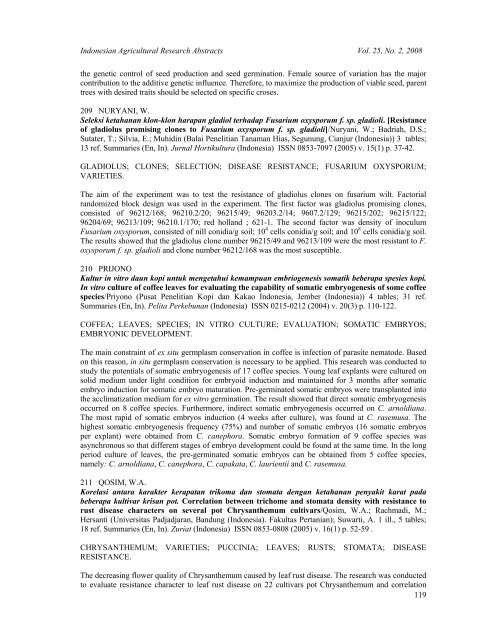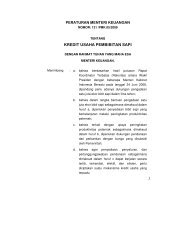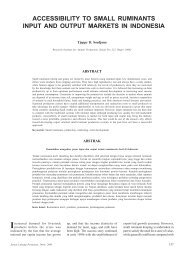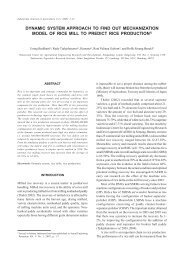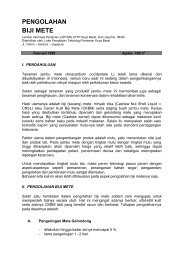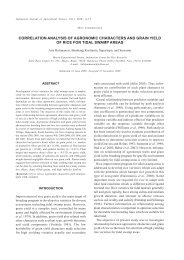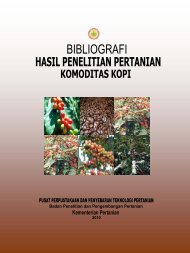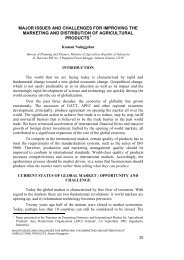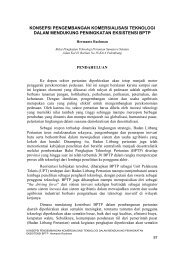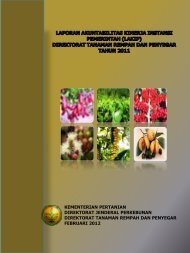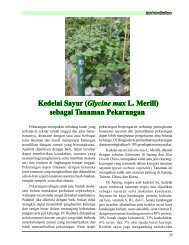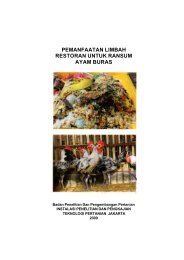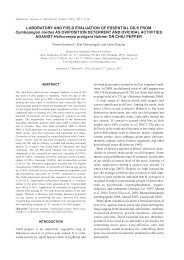<strong>Vol</strong>. 25, <strong>No</strong>. 2, <strong>2008</strong>Indonesian Agricultural Research AbstractsSOLANUM TUBEROSUM; VARIETIES; VARIETY TRIALS; YIELDS; QUALITY; CLONES;TUBERS; SEED POTATOES; PROCESSED PLANT PRODUCTS.<strong>Th</strong>e experiment was conducted at Pangalengan at elevation of 1,300 m asl. Objectives of the research wereto obtain promissing clones for raw material of chips and french fries. Planting was done on August andharvesting was on <strong>No</strong>vember 2002. <strong>Th</strong>e experimental design was randomized completely block designwith three replications. Numbers of plant per plot were 20 hills. Number of clones tested were 16 included3 control varieties. <strong>Th</strong>e results proved that the highest yielding clones were obtained from clonesMerbabu-17 (57.9) followed by 380584.3 (44.4), AGB 69.1 (41.8) and MF-11 (41.1) t/ha and significantlydifferent from control varieties of Atlantic (28.5) and Panda (25.2) t/ha. <strong>Th</strong>e highest marketable yield wereobtained from clones I-1085 (87%), CFQ 69.1 (84%), and TS-2 (83%) significantly different to Atlantic(60%) and Panda (64%). <strong>Th</strong>e highest of specific gravity were obtained from clones TS-2 (1.095), FBA-4(1.084), 378501.3 (1.084), I-1085 (1.084), Panda (1.082), Atlantic (1.080), and MF-II (1.072). <strong>Th</strong>e bestclones for chip were TS -2 and MF-II. Whereas, the best clones for french fries were TS-2 and I-1085. <strong>Th</strong>eimpact of the research was the information on advanced processing clones provided for releasing thevarieties.207 KUSWANTOEvaluasi daya waris sifat ketahanan kacang panjang terhadap CABMV berdasarkan strukturkekerabatan. Evaluating the inheritability characteristic of the Hindu pea (kacang panjang)resistance to CABMV based on genetic relationship/Kuswanto; Kasno, A.; Soetopo, L.; Hadiastono, T.(Universitas Brawijaya, Malang (Indonesia). Fakultas Pertanian) 23 ref. Appendices Summaries (En, In).Jurnal Ilmu-Ilmu Hayati (Indonesia) ISSN 1410-413X (2004) v. 16(2) p. 182-189.COWPEAS; VARIETIES; HIGH YIELDING VARIETIES; HERITABILITY; DISEASE RESISTANCE;COWPEA MOSAIC COCOMOVIRUS.<strong>Th</strong>e objective of this research was to obtain high yielding varieties of the cowpea were resistant to cowpeaaphid born mosaic virus (CABMV). <strong>Th</strong>is is important to Indonesia as the cowpea as a cheap source of dietprotein and fibre. <strong>Th</strong>e trials were conducted in the green house and Brawijaya University ExperimentalFarm from <strong>No</strong>vember 2002 to October 2003. <strong>Th</strong>e materials used were 4 segregated groups of plants of 2resistant varieties (MLG 15151 and MLG 15167) crossed with 2 high yielding varieties (HS and PS),respectively. Inheritance potential was estimated through a narrow heritability analysis based on geneticrelationship arrangement. Results indicated that all crossed groups of HS/MLG 15151, HS/MLG 15167,PS/MLG 15151 and PS/MLG 15167 need further improvement to their resistance. <strong>Th</strong>e HS/MLG 15151,HS/MLG 15167 and PS/MLG 15167 groups resistance could be improved through back crossing, whereasPS/MLG 15151 resistance could be improved via a modified bulk method.208 MULAWARMANDaya silang pada hibridisasi interspesifik antara Eucalyptus pellita dan E. urophylla. Cross ability ininterspecific hybrid between Eucalyptus pellita and E. urophylla/Mulawarman; Sastrosumarto, S.;Naiem, M. 5 tables; 32 ref. Summaries (En, In). Zuriat (Indonesia) ISSN 0853-0808 (2003) v. 14(2) p.12-20.EUCALYPTUS PELLITA; EUCALYPTUS UROPHYLLA; ARTIFICIAL POLLINATION;INTERSPECIFIC HYBRIDIZATION; GENETIC CONTROL; GENETIC VARIATION; SEEDPRODUCTION; GERMINABILITY.A controlled crossing experiment using a factorial mating design, involving female parents of E. pellitaand male parents of E. urophylla that randomly sampled from the breeding population of both species, wasconducted to assess the degree of genetic control on interspecific crossability for hybrid between E. pellitaand E. urophylla. As measures of crossability, number of seeds per capsule and percentage of germinatedseed were determined for each individual cross. <strong>Th</strong>e effect of female, male and female x male wassignificant on number of seed per capsule and percentage of germination. <strong>Th</strong>ere was a slight tendency thatthe family produced more seeds might produce less viable seed. Additive and dominance genetic varianswere estimated as measures of the genetic control. <strong>Th</strong>e dominance variance had the major contributon to118
Indonesian Agricultural Research Abstracts <strong>Vol</strong>. 25, <strong>No</strong>. 2, <strong>2008</strong>the genetic control of seed production and seed germination. Female source of variation has the majorcontribution to the additive genetic influence. <strong>Th</strong>erefore, to maximize the production of viable seed, parenttrees with desired traits should be selected on specific croses.209 NURYANI, W.Seleksi ketahanan klon-klon harapan gladiol terhadap Fusarium oxysporum f. sp. gladioli. [Resistanceof gladiolus promising clones to Fusarium oxysporum f. sp. gladioli]/Nuryani, W.; Badriah, D.S.;Sutater, T.; Silvia, E.; Muhidin (Balai Penelitian Tanaman Hias, Segunung, Cianjur (Indonesia)) 3 tables;13 ref. Summaries (En, In). Jurnal Hortikultura (Indonesia) ISSN 0853-7097 (2005) v. 15(1) p. 37-42.GLADIOLUS; CLONES; SELECTION; DISEASE RESISTANCE; FUSARIUM OXYSPORUM;VARIETIES.<strong>Th</strong>e aim of the experiment was to test the resistance of gladiolus clones on fusarium wilt. Factorialrandomized block design was used in the experiment. <strong>Th</strong>e first factor was gladiolus promising clones,consisted of 96212/168; 96210.2/20; 96215/49; 96203.2/14; 9607.2/129; 96215/202; 96215/122;96204/69; 96213/109; 96210.1/170; red holland ; 621-1. <strong>Th</strong>e second factor was density of inoculumFusarium oxysporum, consisted of nill conidia/g soil; 10 4 cells conidia/g soil; and 10 8 cells conidia/g soil.<strong>Th</strong>e results showed that the gladiolus clone number 96215/49 and 96213/109 were the most resistant to F.oxysporum f. sp. gladioli and clone number 96212/168 was the most susceptible.210 PRIJONOKultur in vitro daun kopi untuk mengetahui kemampuan embriogenesis somatik beberapa spesies kopi.In vitro culture of coffee leaves for evaluating the capability of somatic embryogenesis of some coffeespecies/Priyono (Pusat Penelitian Kopi dan Kakao Indonesia, Jember (Indonesia)) 4 tables; 31 ref.Summaries (En, In). Pelita Perkebunan (Indonesia) ISSN 0215-0212 (2004) v. 20(3) p. 110-122.COFFEA; LEAVES; SPECIES; IN VITRO CULTURE; EVALUATION; SOMATIC EMBRYOS;EMBRYONIC DEVELOPMENT.<strong>Th</strong>e main constraint of ex situ germplasm conservation in coffee is infection of parasite nematode. Basedon this reason, in situ germplasm conservation is necessary to be applied. <strong>Th</strong>is research was conducted tostudy the potentials of somatic embryogenesis of 17 coffee species. Young leaf explants were cultured onsolid medium under light condition for embryoid induction and maintained for 3 months after somaticembryo induction for somatic embryo maturation. Pre-germinated somatic embryos were transplanted intothe acclimatization medium for ex vitro germination. <strong>Th</strong>e result showed that direct somatic embryogenesisoccurred on 8 coffee species. Furthermore, indirect somatic embryogenesis occurred on C. arnoldiana.<strong>Th</strong>e most rapid of somatic embryos induction (4 weeks after culture), was found at C. rasemusa. <strong>Th</strong>ehighest somatic embryogenesis frequency (75%) and number of somatic embryos (16 somatic embryosper explant) were obtained from C. canephora. Somatic embryo formation of 9 coffee species wasasynchronous so that different stages of embryo development could be found at the same time. In the longperiod culture of leaves, the pre-germinated somatic embryos can be obtained from 5 coffee species,namely: C. arnoldiana, C. canephora, C. capakata, C. laurientii and C. rasemusa.211 QOSIM, W.A.Korelasi antara karakter kerapatan trikoma dan stomata dengan ketahanan penyakit karat padabeberapa kultivar krisan pot. Correlation between trichome and stomata density with resistance torust disease characters on several pot Chrysanthemum cultivars/Qosim, W.A.; Rachmadi, M.;Hersanti (Universitas Padjadjaran, Bandung (Indonesia). Fakultas Pertanian); Suwarti, A. 1 ill., 5 tables;18 ref. Summaries (En, In). Zuriat (Indonesia) ISSN 0853-0808 (2005) v. 16(1) p. 52-59 .CHRYSANTHEMUM; VARIETIES; PUCCINIA; LEAVES; RUSTS; STOMATA; DISEASERESISTANCE.<strong>Th</strong>e decreasing flower quality of Chrysanthemum caused by leaf rust disease. <strong>Th</strong>e research was conductedto evaluate resistance character to leaf rust disease on 22 cultivars pot Chrysanthemum and correlation119
- Page 2: ISSN: 0216-3713INDONESIAN AGRICULTU
- Page 7 and 8: Indonesian Agricultural Research Ab
- Page 9 and 10: Indonesian Agricultural Research Ab
- Page 11 and 12: Indonesian Agricultural Research Ab
- Page 13 and 14: Indonesian Agricultural Research Ab
- Page 15 and 16: Indonesian Agricultural Research Ab
- Page 17 and 18: Indonesian Agricultural Research Ab
- Page 19 and 20: Indonesian Agricultural Research Ab
- Page 21 and 22: Indonesian Agricultural Research Ab
- Page 23 and 24: Indonesian Agricultural Research Ab
- Page 25 and 26: Indonesian Agricultural Research Ab
- Page 27: Indonesian Agricultural Research Ab
- Page 31 and 32: Indonesian Agricultural Research Ab
- Page 33 and 34: Indonesian Agricultural Research Ab
- Page 35 and 36: Indonesian Agricultural Research Ab
- Page 37 and 38: Indonesian Agricultural Research Ab
- Page 39 and 40: Indonesian Agricultural Research Ab
- Page 41 and 42: Indonesian Agricultural Research Ab
- Page 43 and 44: Indonesian Agricultural Research Ab
- Page 45 and 46: Indonesian Agricultural Research Ab
- Page 47 and 48: Indonesian Agricultural Research Ab
- Page 49 and 50: Indonesian Agricultural Research Ab
- Page 51 and 52: Indonesian Agricultural Research Ab
- Page 53 and 54: Indonesian Agricultural Research Ab
- Page 55 and 56: Indonesian Agricultural Research Ab
- Page 57 and 58: Indonesian Agricultural Research Ab
- Page 59 and 60: Indonesian Agricultural Research Ab
- Page 61 and 62: Indonesian Agricultural Research Ab
- Page 63 and 64: Indonesian Agricultural Research Ab
- Page 65 and 66: Indonesian Agricultural Research Ab
- Page 67 and 68: Indonesian Agricultural Research Ab
- Page 69 and 70: Indonesian Agricultural Research Ab
- Page 71 and 72: Indonesian Agricultural Research Ab
- Page 73 and 74: Indonesian Agricultural Research Ab
- Page 75 and 76: Indonesian Agricultural Research Ab
- Page 77 and 78: Indonesian Agricultural Research Ab
- Page 79 and 80:
Indonesian Agricultural Research Ab
- Page 81 and 82:
Vol. 25, No. 2, 2008BODY WEIGHT251,
- Page 83 and 84:
Vol. 25, No. 2, 2008EVALUATION210EX
- Page 85 and 86:
Vol. 25, No. 2, 2008LACTUCA SATIVA1
- Page 87 and 88:
Vol. 25, No. 2, 2008PROPAGATION MAT
- Page 89 and 90:
Vol. 25, No. 2, 2008VVANILLA PLANIF


